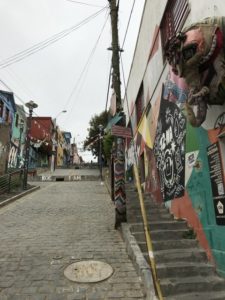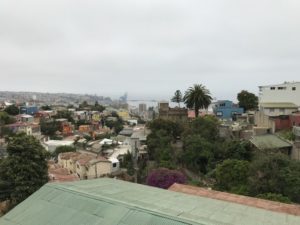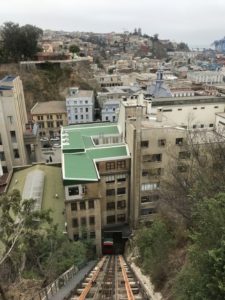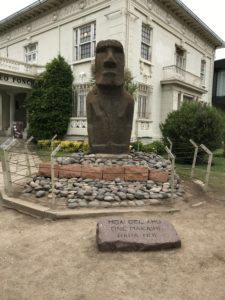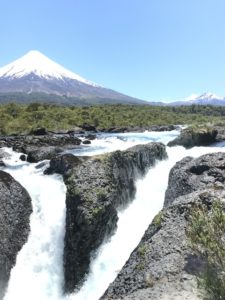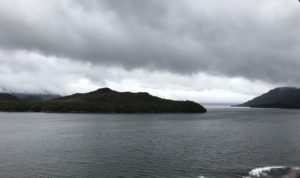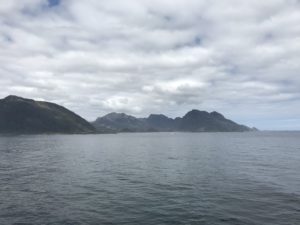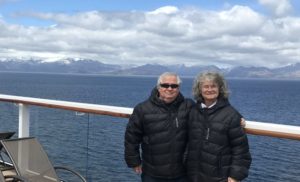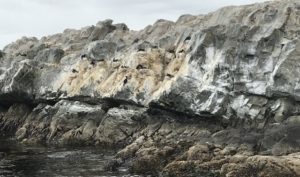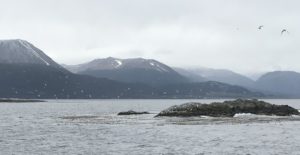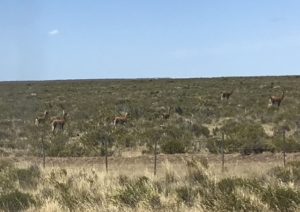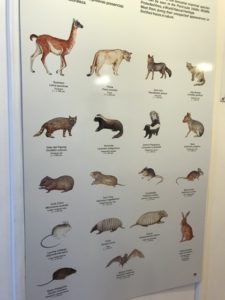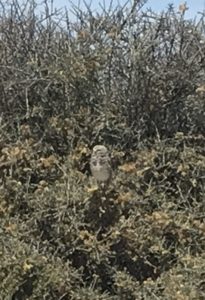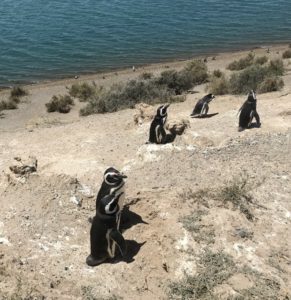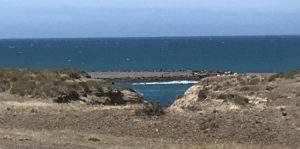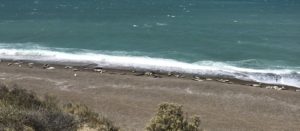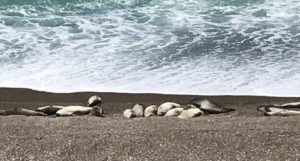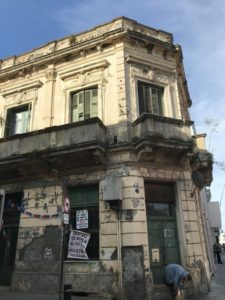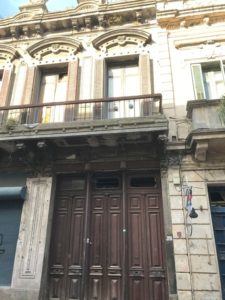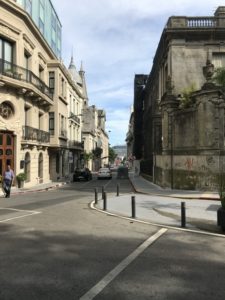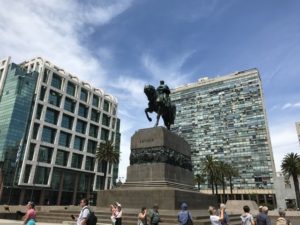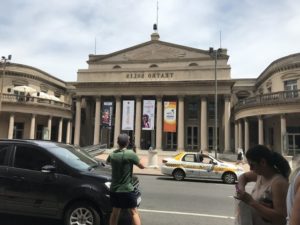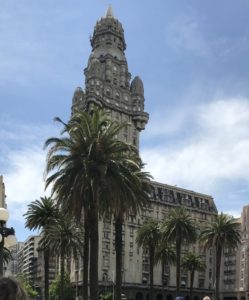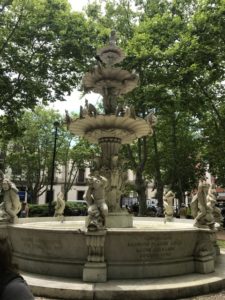We arrived in Santiago in the morning and took a taxi to our hotel, the Marriott, in a wealthy area of town. We had planned to do a walking tour of downtown, but the hotel recommended we not do it and not take the subway because so many stations were shut down due to the protests. The protests have been going on foe 50 days and center on demands for health care, better pensions, and lower costs of education. They began when the government announced plans to raise metro fares. Taxes are 18% and people feel the government is corrupt are not providing them with services. We opted to have a seafood lunch ( a bucket of mussels I couldn’t finish and hake, the most popular fish in Chile) and recover from the plane flight. I’m glad we decided against either the hop on bus or a taxi tour because much of the downtown was shut down due to the protests. It was in the 90’s and the smog made visibility poor. After a nap and a swim, we wandered out to an upscale shopping area and had a wonderful seafood dinner at La Perla del Pacifico ( calamari, crab bake, and more wonderful hake).
Category Archives: South America Cruise
From Santiago to Valparaiso, Vina Del Mar, and San Antonio port
We booked a tour that would take us to the cruise ship in San Antonio via Valparaiso and neighboring Vina Del Mar (for about the same price as a transfer to the boat). In picking up the other passengers for the excursion, we got a tour of the downtown area, where most of the stores are closed and boarded up, graffiti covers everything, and even traffic lights have been destroyed, making navigating intersections without traffic cops challenging. The entire downtown area is lined with barricades and we saw lines of paint splattered armored vehicles.

Outside of Santiago, we drove through the Casablanca Valley. The countryside is very dry, river beds are dry, and we saw evidence of recent fires that are whipped up by high winds. We stopped at a winery that had been covered in corrugated steel to protect it from protesters who were traveling by bus to protest in Valparaiso.
We saw lots of people walking along the highway with backpacks. It turns out they are pilgrims heading to celebrate the feast of the Immaculate Conception on 12/8, the largest religious festival in Chile. The day before the festival, the highway will be shut down to accommodate over a million pilgrims making their way to the monastery perhaps 40 miles outside of Santiago.
Valparaiso was once the busiest port in Chile before the Panama Canal opened ( when ships had to go around Cape Horn to transit from the Pacific to the Atlantic). It’s a beautifully old city, a UNESCO World Heritage site, but unfortunately marred by graffiti and protests ( since the Congress is in Valparaiso).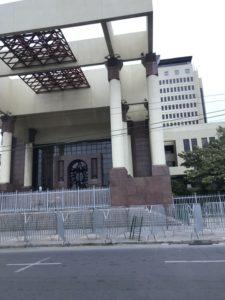
The steep roads up the hills of Valparaiso are full of colorful street art.
We visited Pablo Neruda’s house overlooking the port.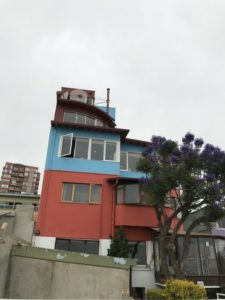
 Many of the lovely old homes have been turned into hotels or museums.
Many of the lovely old homes have been turned into hotels or museums.
We also rode the Cerro Alegre Valparaiso funicular.
Next we visited Plaza S0t0mayor with its Wedgwood naval building and its new building built inside of the old. 
Right next door to Valparaiso is Vina Del Mar, the newer, wealthier city.
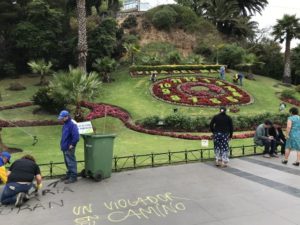
Vina del Mar Flower Clock with workers trying to remove graffiti from a recent demonstration.
In Vina Del Mar, we saw one of the Easter Island moats donated by the Rapanui people to the city.
On the way to the boat in the port of San Antonio ( cruise ships moved to the new port after union protests shut the Valparaiso port several years ago), we stopped at The Indomita winery in the Casablanca Valley, the Chilean capital for cold climate white wines.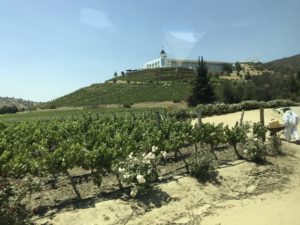
Puerto Montt, Chile
Puerto Montt was settled by German settlers in 1852. The Chilean government gave land to German settlers, who must have felt quite at home since the area looks like Bavaria, with a temperate climate, a huge lake with views of two snow-capped active volcanoes, Osorno and Puntiagudo.  We visited the first Chilean national park, established in 1913, the Vincente Rosales park, where we saw the Saltos del Petrohue waterfall that is spectacular because of the aqua blue glacial waters that cascade through black volcanic rock.
We visited the first Chilean national park, established in 1913, the Vincente Rosales park, where we saw the Saltos del Petrohue waterfall that is spectacular because of the aqua blue glacial waters that cascade through black volcanic rock.
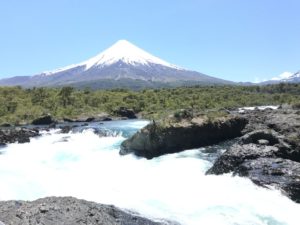
Next, we visited Puerto Vargas, established in 1853, where the founder of both Patagonia and North Face lived and died here in 2015 (and donated thousands of acres in Patagonia)
It is truly a gorgeous area, think Lake Como in Bavaria with snow-capped volcanoes. We also stopped briefly at the German Museum.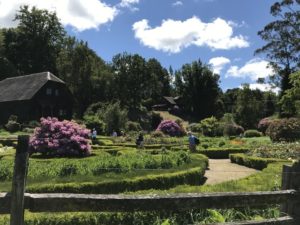
Next, we visited Frutillar, another German town. It is also on the lake with views of the volcanoes.
When we were boarding the ship in Puerto Montt, we saw lots of people at the beach.. it is their summer here and temperatures were in high 70s and low 80s. 
Chilean Fjords
We were in the northern Chilean fjords until 1 pm yesterday after we went back out to sea, where it was considerably rougher. Today at 1 pm we re-entered the fjords and have been cruising through them all day. The Chilean fjords are not as tall or steep as those in New Zealand or Newfoundland, but they stretch for 1,600 km and are much more varied. 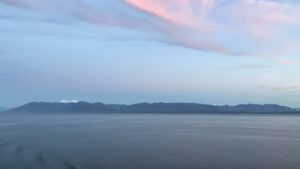
We saw huge flocks of what I think must have been storm petrels yesterday and a variety of albatross, some of which have an 11 ft wing span. Every rocky ledge was covered with seals ( unfortunately too far away to get a good picture).
Today, many of the far peaks are snow-capped. The temperatures are cool in the shade but lovely in the sun, so we have been enjoying our balcony, along with the hot tubs.
Straits of Magellan
We sailed into the Straits of Magellan around 10:30 this morning under blue skies and warm weather. From our balcony, we spotted whale spouts, sometimes two and three at a time. We must have moved by a pod of whales because we saw one spout after another, with the rolling backs and fins of the whales clearly visible. After several dozen sightings we haven’t seen another since.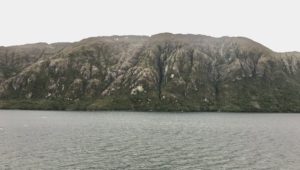
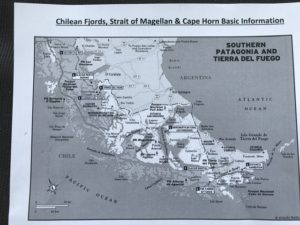
The straits were first charted by the Portuguese sailor Ferdinand Magellan in 1520 under contract to the Spanish king who wanted a safer route for his galleons to bring back plundered gold and silver from the new world. They separate Tierra Del Fuego from the mainland of Chile. At their narrowest, the Straits are just over a mile wide. 
The mountains are getting bigger and more rocky (the white is rock not snow).
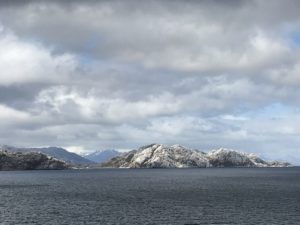
Once again it was a sunny day and even though it was cold on deck, we could enjoy the hot tubs and sitting on our balcony, which was remarkably warm in the sunshine. 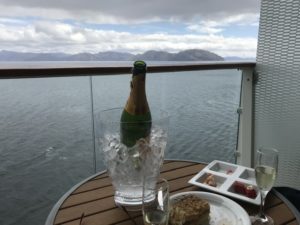
Glacier Avenue and Ushuaia, Argentina
At 4:30 this morning we sailed into Glacier Avenue in the Alberto De Agostini National Park. The sun was coming up and the mountains were spectacular.


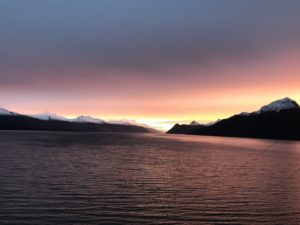
From our balcony we could photograph the glaciers we passed, the Espana, Romanch, Alemania, Francis, Italia, and Hollanda. They are tidewater glaciers that flow from the Darwin Mountains to the ocean.
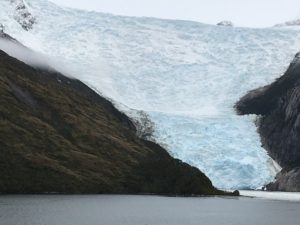
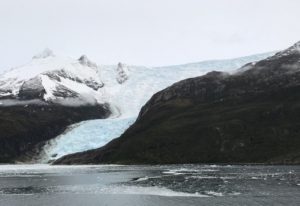
Ushuaia, Argentina, calls itself the southernmost town in the world. It is on the Beagle Channel at the southern end of Tierra Del Fuego, only 750 miles from Antarctica. The sun comes up around 4am and it doesn’t get dark until after 10pm.
We did an excursion that took us to the Tierra del Fuego National Park where we visited the end of Route 3, the Pan-American Highway, a spot that overlooks the Beagle Channel with Chile across the water and Argentina on this side. 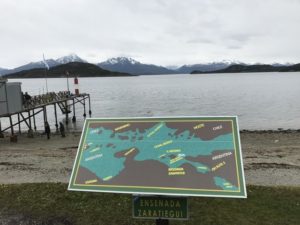 Unfortunately, the spot was overwhelmed with buses from the ship and lost some of its charm. The same went for our next stop at Lake Acigami. Seeing the Park was interesting but I would not recommend doing it on a ship excursion bus, way too many people at each stop.
Unfortunately, the spot was overwhelmed with buses from the ship and lost some of its charm. The same went for our next stop at Lake Acigami. Seeing the Park was interesting but I would not recommend doing it on a ship excursion bus, way too many people at each stop.
The park and the entire island has been plagued by terrible decisions about importing animal to solve problems, which of course created more problems. They imported rabbits to solve some problem; then imported foxes to kill the rabbits, but the foxes preferred the native birds, then they imported beavers, which proceeded to destroy forests.That seems to be the sad story of so many islands we have visited, Hawaii and New Zealand to name just two.
The afternoon portion of the trip made up for the unpleasant morning of bus hell. We took a catamaran out of Lapataia Bay into the Beagle Channel, where we saw the end of the world lighthouse with nesting Imperial cormorants and the slightly smaller rock or Magellan cormorants.
Next, we sailed by several small rock outcrops with sea lions. The first held mostly females.
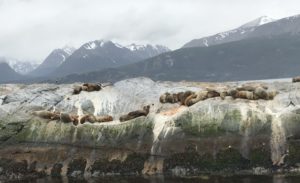
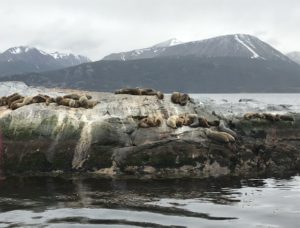
Next we sailed by an island of nesting South American terns making quite a racket.
Then we sailed by an island with yet more cormorants, Several white kelp geese, and flightless Stanley ducks.
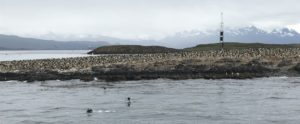
The last island we passed had several male sea lions.
Earlier, we saw a chimango caracara. 180 years ago, Charles Darwin sailed these waters on his historic H.M.S. Beagle expedition. Today, one can still see the variety of bird and animal life that fascinated him.This was one of the most spectacular days of the trip so far.
Cape Horn, Chile
Between 6:00 and 8:00 this morning we approached Cape Horn, the southernmost point in the Americas. 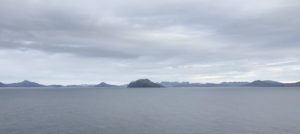 Named after the Dutch town of Hoorn in 1616 by the Dutchman who first rounded it, Cape Horn the northern boundary of the Drake Passage and marks where the Atlantic and Pacific Oceans meet.
Named after the Dutch town of Hoorn in 1616 by the Dutchman who first rounded it, Cape Horn the northern boundary of the Drake Passage and marks where the Atlantic and Pacific Oceans meet.
 The Dutch merchant who first rounded Cape Horn was looking for an alternative route to the Magellan Straits, which were controlled by the East India Company. The Straits and the Beagle Channel are very narrow and subject to williwaw winds that can strike without warning. The advantage of the Drake Passage around Cape Horn was that it is 500 miles wide, allowing sailing ships more room to maneuver against winds, waves, and tides. The passage is nonetheless treacherous, known for strong winds and waves. The Bounty battled the winds for 40 days before Captain Bly turned the boat around and chose to sail around African instead.
The Dutch merchant who first rounded Cape Horn was looking for an alternative route to the Magellan Straits, which were controlled by the East India Company. The Straits and the Beagle Channel are very narrow and subject to williwaw winds that can strike without warning. The advantage of the Drake Passage around Cape Horn was that it is 500 miles wide, allowing sailing ships more room to maneuver against winds, waves, and tides. The passage is nonetheless treacherous, known for strong winds and waves. The Bounty battled the winds for 40 days before Captain Bly turned the boat around and chose to sail around African instead.
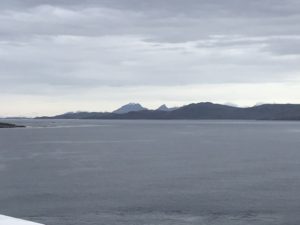 We were lucky to have calm seas and little wind when we approached. Winds can be fierce and waves are typically 10 feet.
We were lucky to have calm seas and little wind when we approached. Winds can be fierce and waves are typically 10 feet.

The Chilean Navy maintains the lighthouse on Cape Horn which is part of the Cabo de Hornos (Cape Horn) National Park, a UNESCO protected ecosystem. Created in the 1940s, this 155,906-acre national park has craggy cliffs and windswept beauty. The lighthouse keeper and his wife came out to wave at us. There is a statue with the outline of an albatross commemorating the more than 10,000 sailors who lost their lives on 800 shops that sank attempting the passage. 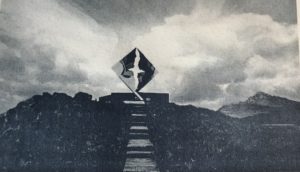
Puerto Madryn, Argentina
This deep water port was founded in 1865 by Welsh immigrants. Extending out into the Atlantic from Puerto Madryn is the Península Valdés, a UNESCO World Heritage wildlife sanctuary where southern right whales mate in its sheltered waters, and sea lions, penguins and elephants seals all have breeding colonies.
The land is flat and dry and we had a two hour bus ride to reach the peninsula, but once we did, we saw lots of guanacos (Related to camels) in groups of 8-15. There are 3,000 in the park and like all the animal, they are protected. Guanacos and vicuña are the wild versions of the domesticated llama and alpaca.
We stopped at a museum where they had a young whale skeleton and charts os birds and animals. 
 One animal that is found nowhere else is the Patagonian Mara, which looks like a jack rabbit but is related to rodents. Peninsula Valdez is also the only place in the world where orca whales swim up on the beach to take sea lion cubs. Apparently, the whales are teaching each other this hunting technique.
One animal that is found nowhere else is the Patagonian Mara, which looks like a jack rabbit but is related to rodents. Peninsula Valdez is also the only place in the world where orca whales swim up on the beach to take sea lion cubs. Apparently, the whales are teaching each other this hunting technique.
Our first stop was at Puerto Piramides, so called because of the pyramid shaped hills, where sea lions come to mate in spring. It is a spectacular location with a shelf where the sea lions are safe from predators. 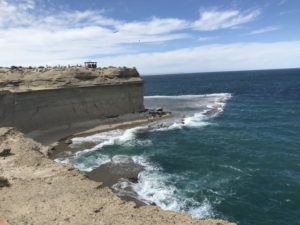

On our way across the peninsula, we were lucky enough to see two burrowing owl chicks come out of their burrow while the parent stood guard. 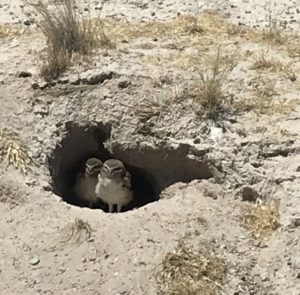
Next, we stopped at a penguin rookery at Caleta Valdez, where there are fewer penguins than on Magdalena Island, but we were very close to them, only separated by a fence.
This area has a very long sandbar that shelters both sea lions and elephant seals. The two populations can occupy the same space because they breed at slightly different times.
The elephant seas were molting when we were there, so they move as little as possible for the almost one month it takes them to molt or shed their fur and skin, revealing a new coat beneath.
Montevideo, Uruguay
We missed Punta Del Este, Uruguay, because there was a medical emergency that caused us to return to Puerto Madryn to get a passenger to a hospital, so we had an extra sea day before arriving in Montevideo (which was fine with me because I was recovering from a cold). Luckily, by the time we arrived in Montevideo, I was feeling up to exploring the town, which is very close to the port. We got off early, before anything was open and the streets were deserted.
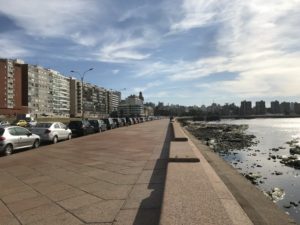
Montevideo was voted the 5 th best city to live in the Americas, and I can see why. The old city has graceous old buildings, lots of pedestrian streets and very little traffic.
We had planned to do a walking tour that didn’t start until 11am, so we returned to the boat to rest until 10:30. The tour started at Plaza de Independencia and explored the old town.
Teatro Solis was the first theater in South America. Montevideo also has a carnival that lasts from mid January to the beginning of March (40 days).
Palacio Salvo has a sister building in Buenos Aires. It began life as a luxury hotel but was soon converted into office space and private apartments.
Uruguay is a very European city (94% os their DNA is European) and it’s a remarkably liberal country. It separated church and state when it adopted its constitution, and granted women the right to vote in 1913. Just recently, they legalized abortion, gay marriage, and recreational marijuana use. Apparently, as a result, narcotics trafficking has been drastically reduced. Their economy is among the strongest in South America.
Plaza Constitution is the old Spanish colonial square, with both the cathedral and government buildings.
There is a great market and restaurant complex right next to the port, but it was too warm for a big meal (mostly beef) so we decided to return to the ship to rest our weary legs after having walked 6 or 7 miles. Montevideo is a very walkable and visitor friendly city.




